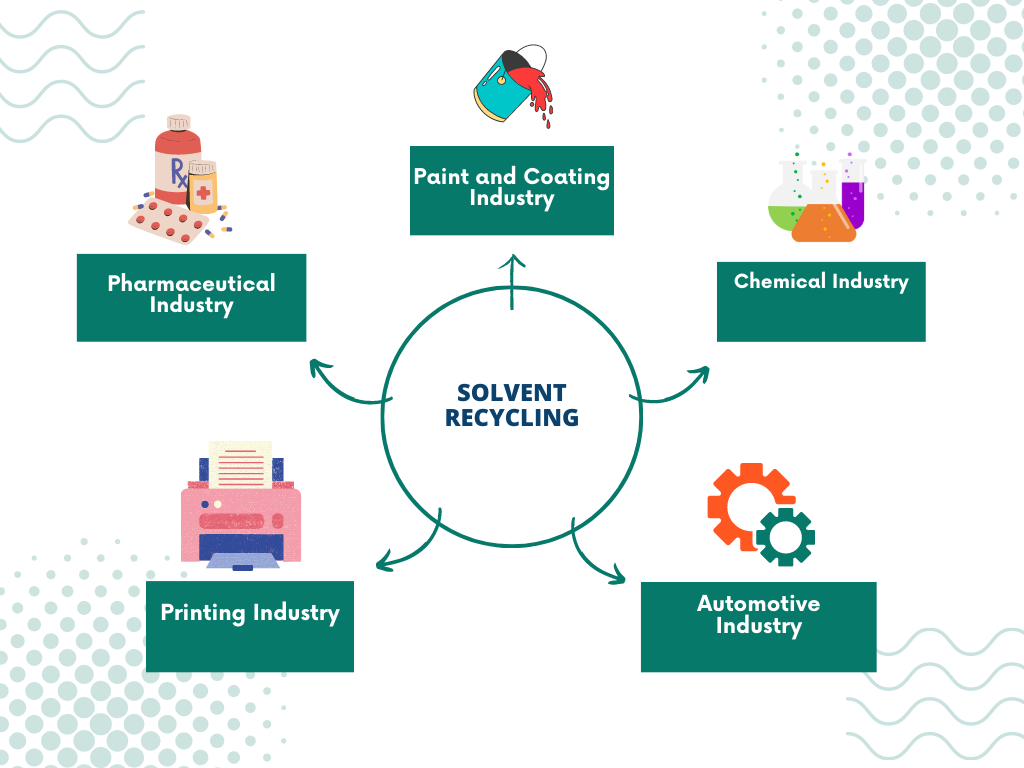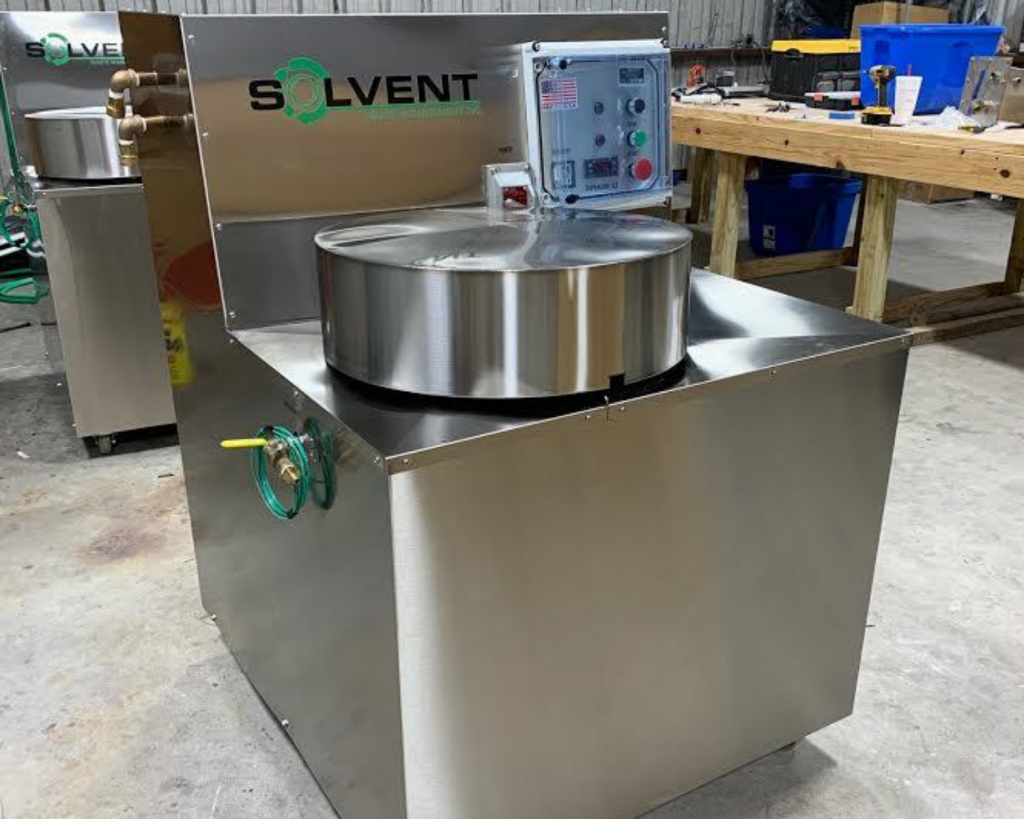What Solvent Recovery Is?
Solvent recovery is a critical process for businesses that use solvents in their production processes. Recovering and reusing solvents can help reduce operating costs, increase profitability, and minimize waste. This is particularly important for industries such as pharmaceuticals, chemicals, and electronics, which rely heavily on solvents in their operations.
In addition to the cost savings, solvent recovery can also reduce the environmental impact of these industries by minimizing the number of hazardous chemicals that are released into the environment.
As per the sources, The global market value of solvent recycling equipment is expected to reach around one billion U.S. dollars by 2022.
What Are The Benefits Of Solvent Recovery
Solvent recovery is a critical process that offers numerous benefits for businesses and the environment.
By recovering and reusing solvents that would otherwise be discarded as waste, businesses can significantly reduce their operating costs. This is particularly crucial for industries that rely heavily on solvents in their production processes, as solvent recovery can help these businesses save money and increase their profitability.
Furthermore, solvent recovery helps reduce the amount of waste that businesses generate, minimizing their environmental impact and promoting sustainability.
Additionally, many solvents are hazardous and can pose a threat to human health and the environment if not properly disposed of. Solvent recovery helps reduce the release of hazardous chemicals into the environment, thus promoting improved environmental impact.
By adopting solvent recovery practices, businesses can significantly minimize their environmental footprint and contribute to a more sustainable future.
Overall, solvent recovery is an essential practice for businesses that use solvents in their production processes. Through solvent recovery, businesses can reap the benefits of cost savings, reduced waste, and improved environmental impact.

Solvent Recovery for the Pharmaceutical Industry
Solvent recovery plays a crucial role in the pharmaceutical industry, where solvents are used in the production of medicines and drugs. Recovery of solvents used in the industry not only helps in reducing production costs but also aids in minimizing environmental pollution.
Pharmaceutical industries use advanced technologies such as distillation, membrane separation, and adsorption to recover solvents. With solvent recovery, the pharmaceutical industry can also meet regulatory requirements and reduce the need for hazardous waste disposal.
Solvent Recovery for the Paint and Coatings Industry
The paint and coatings industry uses a wide range of solvents in its production processes. Solvent recovery in this industry helps reduce costs by recovering solvents that would otherwise be lost as waste.
Recovery of solvents can be accomplished using technologies such as fractional distillation and adsorption. Solvent recovery not only helps reduce waste and operating costs but also contributes to the sustainable use of resources. By implementing solvent recovery practices, the paint and coatings industry can promote sustainability and improve its environmental impact.
Solvent Recovery for the Printing Industry
Solvent recovery is an essential practice for the printing industry, where solvents are used in printing inks and cleaning processes. Recovery of solvents used in the industry helps reduce operating costs and minimize environmental pollution.
The printing industry uses a range of solvent recovery technologies such as distillation, adsorption, and membrane separation to recover solvents. By implementing solvent recovery practices, the printing industry can reduce waste, promote sustainability, and meet regulatory requirements.
Solvent Recovery for the Automotive Industry
Solvent recovery is an important process for the automotive industry, where solvents are used in the production of parts and cleaning processes. Recovery of solvents used in the industry helps reduce operating costs and minimize environmental pollution.
The automotive industry uses various solvent recovery technologies such as fractional distillation, adsorption, and membrane separation to recover solvents. By implementing solvent recovery practices, the automotive industry can promote sustainability and improve its environmental impact.
Solvent Recovery for the Chemical Industry
Solvent recovery is a critical process for the chemical industry, where solvents are used in various processes such as extraction, synthesis, and purification. Recovery of solvents used in the industry not only helps reduce operating costs but also aids in minimizing environmental pollution.
The chemical industry uses a range of solvent recovery technologies such as distillation, adsorption, and membrane separation to recover solvents. By implementing solvent recovery practices, the chemical industry can reduce waste, promote sustainability, and meet regulatory requirements.
Types of Solvent Recovery Methods
Distillation: Distillation is the most common method for solvent recovery. It involves heating the waste solvent to a high temperature, causing it to evaporate. The vapours are then condensed and collected in a separate container.
Distillation is effective at recovering pure solvents and is suitable for recovering large volumes of solvents. However, it requires significant energy input and can be expensive to operate.
Fractional Distillation: Fractional distillation is similar to distillation but involves separating the solvent into its various components. It is useful when the solvent mixture contains multiple components with different boiling points.
The process involves heating the waste solvent and condensing the vapours at various stages to collect different fractions of the solvent. Fractional distillation can recover more solvents than simple distillation, but it is more complex and requires additional equipment.
Membrane Separation: Membrane separation is a method that involves using a membrane to separate the solvent from the waste stream. The solvent passes through the membrane while impurities and other components are left behind.
This method is suitable for separating solvents from dilute waste streams and can be operated at a lower energy cost than distillation. However, it is less effective at separating solvents from concentrated waste streams.
How Solvent Recovery Works
The basic process of solvent recovery involves several stages: collection, separation, purification, and reuse/recycling.
Collection: The first step in solvent recovery is to collect the used solvent. This can be done by various means, such as draining the solvent from the process equipment or using a vacuum system to extract the solvent vapours from the air.
Separation: Once the solvent has been collected, it needs to be separated from any impurities or other chemicals that may be present. There are several methods for separating solvents, including distillation, fractional distillation, and membrane separation. These methods work by using heat, pressure, or a permeable membrane to separate the solvent from other substances.
Purification: After the solvent has been separated from impurities, it may need to be further purified to remove any remaining contaminants. This can be done by using additional distillation or other purification methods, such as adsorption or filtration.
Reuse/recycling: Once the solvent has been purified, it can be reused in the production process or recycled for use in other applications. Reusing the solvent can help reduce operating costs and minimize waste while solvent recycling can help conserve natural resources.
By collecting, separating, purifying, and reusing/recycling solvents, businesses can improve their environmental performance and contribute to a more sustainable future.
The Cost of Solvent Recovery
Implementing a solvent recovery machine can involve significant upfront costs, including the cost of purchasing or leasing the equipment, installation costs, and any necessary modifications to the production process.
The cost of the machine itself can vary depending on factors such as its size, capacity, and complexity. Additionally, ongoing operating costs such as maintenance, energy consumption, and replacement parts should be considered.
However, despite these costs, solvent recovery can ultimately save businesses money by reducing the need to purchase new solvents and by lowering waste disposal costs. The exact cost savings will depend on factors such as the amount of solvent used and the type of industry, but many businesses find that the investment in a solvent recovery machine pays off in the long run.
The environmental benefits of solvent recovery can also help businesses meet regulatory requirements and improve their reputation with customers and stakeholders.
How Businesses Can Calculate Their Potential Cost Savings From Solvent Recovery
Businesses can calculate their potential cost savings from solvent recovery by analyzing their current solvent use and waste disposal costs. They can then estimate the amount of solvent that can be recovered and reused through solvent recovery, as well as the reduced amount of waste that will need to be disposed of.
The cost savings can then be calculated based on the cost of purchasing new solvents, the cost of waste disposal, and the operating costs of the solvent recovery machine. Businesses can also factor in any potential revenue from selling recovered solvents or byproducts.
It is important to note that the exact cost savings will vary depending on the type of industry, the volume of solvents used, and the specific solvent recovery technology being used. Therefore, businesses should consult with solvent recovery experts and conduct a thorough cost-benefit analysis to determine the potential return on investment for implementing a solvent recovery system.
Learn more about Why is Solvent Recycler Considered the Best Alternative to Solvent Disposal?
Solvent Recovery Services: What to Look for in a Provider
Choosing the right solvent recovery provider is an important decision for businesses. Here are some tips to help you evaluate solvent recovery providers and select the right one for your business:
Consider the provider’s experience: Look for a provider with experience in your industry and a proven track record of success in solvent recovery.
Evaluate the provider’s technology: Make sure the provider’s solvent recovery technology is up-to-date, efficient, and effective for your specific needs.
Assess the provider’s customer service: Choose a provider that offers excellent customer service and support, including on-site training, technical support, and ongoing maintenance and servicing.
Review the provider’s pricing: Compare the pricing and services of different providers to ensure that you’re getting the best value for your investment.
Check for certifications: Look for providers that have certifications such as ISO 9001, which demonstrates a commitment to quality and customer satisfaction.
By selecting the right one for your business, you can ensure that you’re getting the most efficient and effective solvent recovery solution to meet your needs.
Conclusion
In conclusion, implementing solvent recovery in your business can have numerous benefits, including cost savings, waste reduction, and improved environmental impact. By recovering and reusing solvents, you can not only reduce your operating costs but also contribute to a more sustainable future.
If you’re considering implementing solvent recovery in your business, there are many options to choose from, including distillation, fractional distillation, and membrane separation. It’s important to carefully evaluate your specific needs and consider factors such as cost, efficiency, and ease of use when selecting a solvent recovery solution.
Additionally, choosing the right solvent recovery provider can also make a big difference. Consider factors such as their experience, reputation, and customer support when selecting a provider.
Overall, solvent recovery is a valuable practice that businesses of all industries can benefit from. By taking the time to evaluate your options and invest in a solvent recovery solution, you can save money, reduce waste, and contribute to a more sustainable future.
About Solvent Waste Management
Since 1994, Solvent Waste Management, Inc. has assisted many companies in a variety of different industries not only improving their operations but also reducing costs.
Solvent Waste Management Inc. designs and manufactures solvent distillation equipment that cleans contaminated solvents, allowing users to restore and continuously reuse solvents – thereby saving money on the cost of disposal and the cost of new solvents.

Model SW8 Solvent Recovery System
Model SW30 Solvent Cleaning Machine
Model SW55 Solvent Recycler Machine
Model SW70 Solvent Recovery Equipment
Solvent Waste Management designs and manufactures solvent recycling equipment that cleans contaminated solvents in such a way that the customer can reclaim and reuse solvents again and again, thus saving on both the cost of solvent disposal and the cost of new materials.

